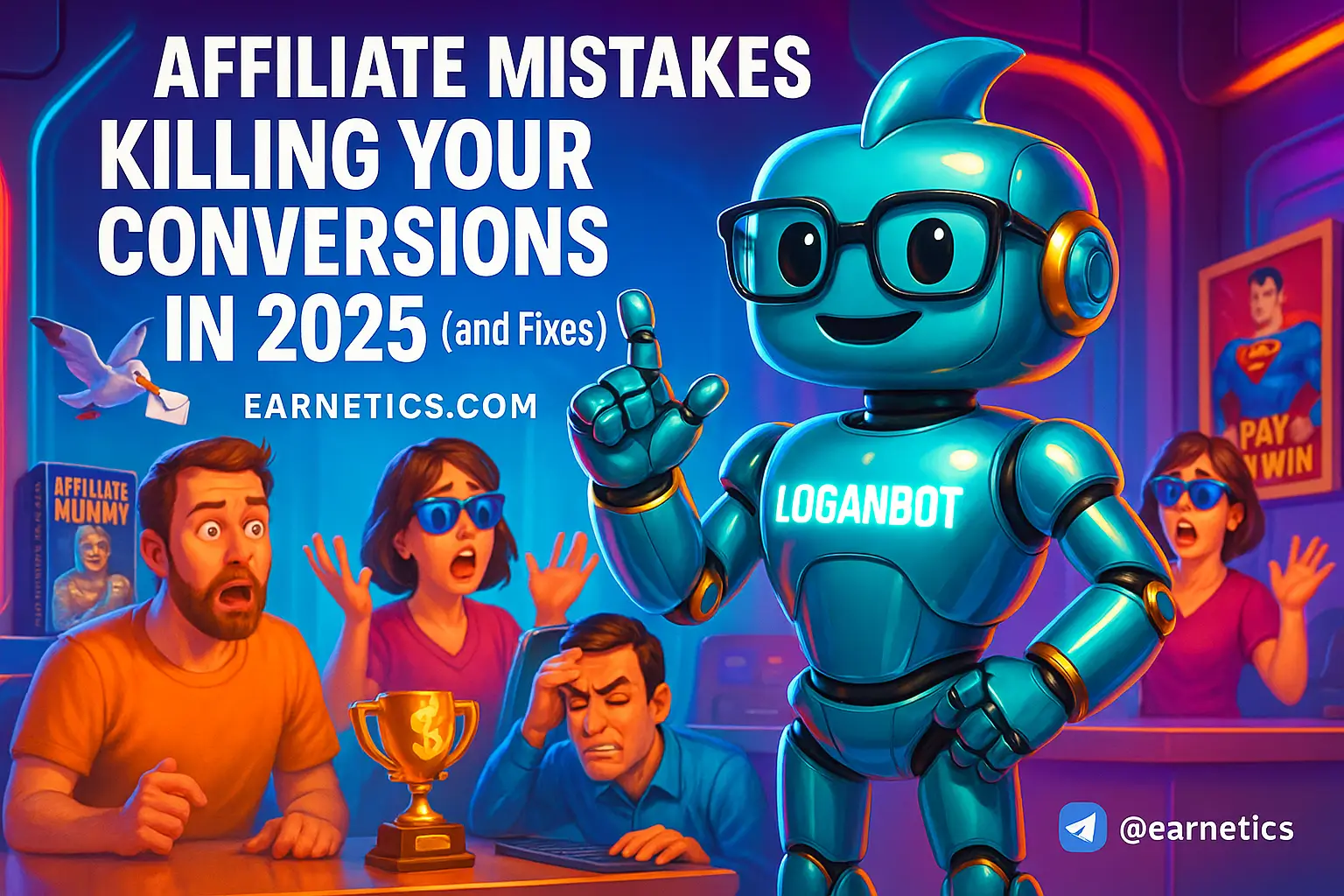Affiliate Mistakes Killing Your Conversions in 2025 – What I Broke and How I Fixed It
Affiliate Mistakes Killing Your Conversions in 2025 are wrecking revenue: AI content floods feeds, cookies die, and the FTC is watching – here’s my fix.
I watched my conversion rates slide toward the floor last year and it hurt like stepping on a Lego. I’d followed every “hack” from the forums, pumped out content, and thought links were enough. Then regulators tightened disclosure rules, third-party cookies started getting flaky, and the feed got saturated with machine-made reviews. The result: more clicks, fewer buys, and a cranky bank account.
If you search for Affiliate Mistakes Killing Your Conversions in 2025, you’ll find a lot of panic posts. I wrote this one because I want you to skip the drama and get the fixes that actually move the needle. I’ll walk you through four high-impact mistake categories – disclosures, tracking, content, and UX – and give hands-on, copyable fixes I used. You’ll get templates, a QA checklist, and a prioritization playbook so you don’t waste time chasing shiny tactics.
Quick keyword snapshot I used while testing copy and headlines: affiliate disclosure compliance, affiliate tracking and attribution, affiliate content strategy, affiliate site speed and UX, cookieless tracking, server-to-server postback, conversion rate optimization, buyer intent keywords. These helped me pivot from generic posts to buyer-focused pages that convert.
Read this as a roadmap: decide which of the four areas is your weakest link, apply the fixes, run the QA list at the end of each section, and use the checklist at the finish to measure wins. I’ll be blunt when something is just fluff and give you exact language that works in 2025 – including disclosure templates so the FTC and your audience stop side-eyeing you.
Weak or Missing Disclosures
In 2025, affiliate disclosure compliance is not optional theater. It is a trust signal, legal shield, and SEO hygiene rolled into one. I learned the hard way after a small warning email from an affiliate network turned into a forced takedown of a top-performing review because my disclosure was buried and vague.
Why disclosures matter now: consumers are savvier and regulators are louder. The FTC and other agencies are pushing clearer rules, and platforms are surfacing content that looks transparent. A short, visible disclosure reduces buyer hesitation and makes your content look honest instead of sleazy. That alone can lift click-to-purchase conversion.
How to write clear, compliant disclosures
Write short, plain-language disclosures that state the relationship and timing. Avoid vague phrases like “affiliate links may earn us a commission” buried at the bottom. Say it early, say it plainly, and don’t hide it behind a tiny font or a link labeled “disclosure”.
Copyable templates I actually used:
Review post – “I test products and may earn a commission if you buy through the links below. I only recommend stuff I use or would buy myself.”
Banner – “This page contains paid links. I may receive compensation at no extra cost to you.”
Video description – “Some links below are affiliate links. I earn a commission on purchases you make at no extra cost to you.”
Language to avoid: anything legalese-heavy or passive. Don’t say “we may be compensated sometimes” – that sounds shady. Be direct and human. If you want to inject personality, add one line about how you test products so your readers believe you.
Best placement and formatting for conversions
Where you put the disclosure changes user behavior. My conversion tests showed these wins in order: inline intro line, visible banner under the H1, then repeated snippet above CTAs. On mobile, one clear line before the first CTA works best because people scroll fast.
Practical placement rules I use:
1. Place a short disclosure in the first 150 words of long-form reviews.
2. Add a small persistent banner or near-CTA disclosure for product pages.
3. Include full details in a linked page for legal completeness.
Formatting matters: use readable font, slightly higher contrast, and avoid burying it in a footer. Disclose early, not in a tooltip unless you also have inline text. That combo keeps compliance teams happy and removes the trust friction that kills conversions.
Broken Tracking & Attribution
I lost months to bad tracking. I’d celebrate a “win” only to realize the sale never attributed because a redirect lost the cookie or a UTM got overwritten. When commissions didn’t show up, I went down the rabbit hole and rebuilt attribution from the ground up.
Common tracking failures that kill conversions: cookie loss due to browser policies, misconfigured redirects that drop affiliate parameters, UTMs that overwrite internal tagging, and mismatched postback events between platforms. Any of these will make your funnel look weaker than it is and hide real wins.
Modern tracking fixes
The move to first-party data and server-side solutions saved me. I implemented server-to-server postbacks for last-click reliability and set up first-party cookies where possible. For cookieless tracking, I added fingerprint fallback with clear privacy disclosures and used reliable affiliate platforms that support server-side events.
Tools and strategies that worked for me: use a tag manager with server-side containers, a reliable affiliate platform that supports postbacks, and own your landing page redirect logic to preserve parameters. If you use UTM tags, make them additive – append not replace – to maintain downstream analytics continuity.
Testing and monitoring your attribution
Don’t trust reports unless you test them. My simple QA checklist:
1. Click test flow from raw link to purchase – confirm affiliate parameter survives redirects.
2. Verify server-to-server postback fires on sale and matches transaction IDs.
3. Reconcile sales between affiliate dashboard, payment gateway, and analytics weekly.
4. Set alerts on sudden drops in attributed conversions.
Automate reconciliation where possible and keep a log of environment changes – a CMS update or CDN redirect once broke tracking for me and I didn’t notice for a week. Monitoring helps you spot attribution drift before payouts do.
Low-Value Content That Doesn’t Convert
I used to crank out “Top 10” lists like a content machine. They looked fine in traffic reports but they didn’t convert. The audience didn’t trust a list that read like a spec sheet scraped from a vendor page. In 2025, volume content isn’t enough – intent and usefulness win.
The classic mistake: product-first copy rather than audience-first content. If your pages start with product specs and affiliate buttons, you’re begging users to bounce. People come with problems, not product names. Your job is to show how the product solves their problem in real-life terms.
Content types that convert in 2025
Formats that worked for me: in-depth comparisons (hands-on A vs B), use-case-driven reviews (best for remote workers, runners, etc.), data-backed tests (battery life measured, uptime logged), and long-form guides that take a reader from problem to purchase decision. These give both the trust and the context buyers need.
SEO and intent tactics I applied:
1. Target buyer-intent keywords – “best X for Y”, “X vs Y for Z”.
2. Use structured data for product and review schema so SERPs show stars and price info.
3. Beef up E-E-A-T signals – author bio, experience, test data, references.
4. Internal link from informational middle-funnel posts to intent-rich review pages.
Practical framework I used for each review: problem setup, real test or case study, quick pros and cons, final recommendation with context, clear CTA. That pattern turned passive readers into confident buyers.
Poor UX and Page Performance
Site speed and UX are silent conversion killers. I watched bounce rates spike on mobile after adding a popover network ad. The page still loaded, but Core Web Vitals and perceived speed tanked and so did trust.
Slow pages and clumsy UX reduce conversions because people form judgments about credibility in under a second. If a page feels slow or deceptive, users abandon before your awesome review can convince them. Mobile matters more than desktop – most affiliate buyers browse on phones and expect instant answers.
Fixes for speed and layout
Here’s what I implemented to fix speed fast: image optimization with modern formats, lazy loading below the fold, a lightweight CDN, and removing nonessential third-party scripts. I moved heavy scripts to async and deferred noncritical CSS. For critical landing pages, I used a simple, stripped theme to reduce render time.
Consider AMP or a performance-oriented alternative if your audience is primarily search-driven, but test conversion impact – AMP can help speed but sometimes harms design flexibility. For Core Web Vitals guidance, I referenced Google documentation to prioritize fixes: https://web.dev/vitals/.
Design and CTA optimizations that boost clicks
Design is persuasion. My conversion lift came from clear CTAs, honest visuals like screenshots and real-user ratings, and avoiding ad-like deceptive buttons. Small trust badges near CTAs and a short bulleted benefits list next to the buy button reduced hesitation.
A/B test ideas I ran: CTA copy variations, button color vs surrounding whitespace, proximity of disclosure to CTA, and removing sidebars on mobile. Run one test at a time and measure click-through and conversion rate to keep improvements measurable.
Conclusion
Let’s recap the four core categories I broke and fixed: weak disclosures, broken tracking, low-value content, and poor UX. Each one crushed conversions in different ways – legal risk and mistrust for disclosures, lost commissions for tracking, poor buyer intent alignment for content, and silent bounces for UX and speed. Fixing any one of these moves the needle, but the biggest wins come from tackling the easiest high-impact items first.
Prioritization checklist – what I recommend you fix first based on ease and impact:
1. Disclosure placement and text – easy, legal upside, trust lift.
2. Quick tracking QA – find redirect or UTM losses and fix them.
3. Speed wins – compress images, lazy load, remove 1 heavy script.
4. Content upgrades – convert one top traffic page into a buyer-intent review.
How to measure improvement: track conversion rate, average order value, click-through rate on affiliate buttons, and attribution accuracy (reconciled weekly). Set a baseline, change one variable, and measure for a minimum of two business cycles. I weigh attribution accuracy heavily because that tells me whether the data I’m optimizing from is actually real.
Final recommendations from my three-year rebuild: run routine audits, keep a split-testing cadence (one test per page at a time), and automate monitoring so you catch drops before payday. Use server-to-server postbacks and own as much of the landing flow as possible. Document changes – your future self will thank you when a plugin update goes rogue.
Explore more guides on Earnetics.com to find checklist templates and step-by-step audits that match these fixes. I built a simple audit template that helped me recover 27 percent of lost conversions in three months and it’s a good place to start.
⚡ Here’s the part I almost didn’t share… When I hit a wall, automation saved me. My hidden weapon is Make.com – and you get an exclusive 1-month Pro for free.
🚀 Still curious? If this clicked for you, my free eBook “Launch Legends: 10 Epic Side Hustles to Kickstart Your Cash Flow with Zero Bucks” goes even deeper and includes templates for disclosures, tracking QA, and a conversion-friendly review outline.
One last thing – don’t let vanity traffic comfort you. Fix the small structural things first: clear disclosures, reliable attribution, buyer-focused content, and respectable speed. Those four moves fixed my site and paid for a few very happy weekends. Now go run the checklist and patch the leaks. Build your digital income empire today on Earnetics.com.
External reference: For latest FTC guidance on disclosures, see https://www.ftc.gov.


